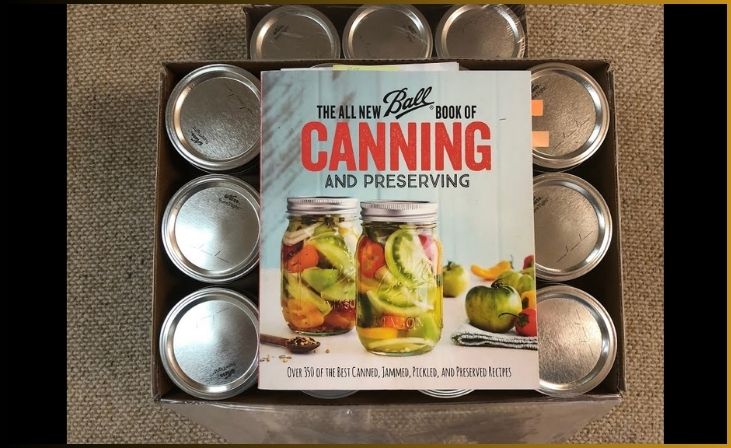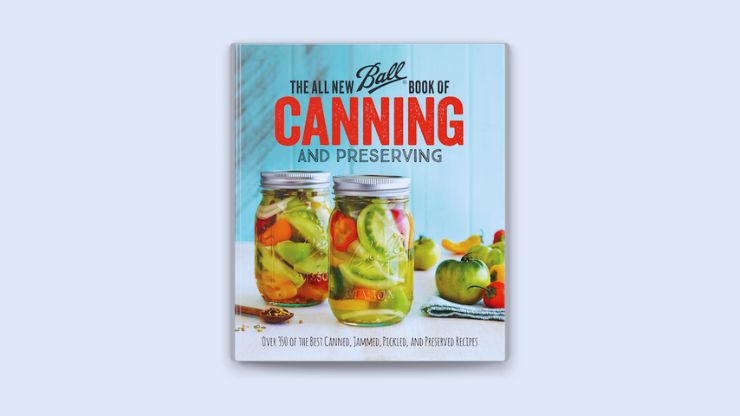My first introduction to “putting food by” was with a 1969 edition of the Ball Blue Book. So in reading this post, I was thrilled to see the inclusion of fermentation in the new edition. If you are on the fence about spending $15 for this new edition, read the review to see what might be in store.
Welcome to the culinary world of preservation and flavor mastery with “The All New Ball Book of Canning and Preserving.” You’d be hard-pressed to find a modern canning book that even makes a passing mention of fermenting. Or so I thought. The All New Ball Book of Canning and Preserving actually lives up to its name and reviews ferments in depth. A full chapter begins with step-by-step pictorial instructions on fermenting your own sauerkraut for the beginning fermenter.
Generally, Ball canning books stick to the basics of jams and jellies, so this new concentration on fermenting is an exciting step, as they expand their understanding of preserving to include methods that have been around since long before the advent of home water baths and pressure canning.
Table of Contents
ToggleThe All New Ball Book of Canning and Preserving
In this comprehensive guide, we embark on a journey into the art and science of canning, exploring the latest techniques and recipes that redefine the landscape of home preservation. From vibrant jams to savory pickles, join us in uncovering the secrets and innovations that make this edition an indispensable companion for both seasoned preservers and newcomers to the craft. Let the canning adventure begin!
Quick Link: Nourishing Traditions Book Review
A Book Review

I imagine many of the people who purchased this book didn’t expect to find information on fermenting at all, and may not even know about home fermenting as a process. Given that it may be someone’s first introduction to fermenting, I’m glad that beautiful and surprisingly detailed photos are there to take the new fermenter through every step in the process.
Beyond the basics of fermenting, I was delighted to find inventive new ways to ferment with fruit-flavored kimchi, probiotic mustards, homemade Worcestershire sauce, and salt-preserved lemons. I was even introduced to completely new fermented foods such as harissa, an intense North African condiment based on chilis and spices, and tepache, a fermented South American pineapple drink.
Outside of the fermentation chapter, I’m impressed that the authors also work to explicitly promote probiotic foods in their preserves.
Don't just scroll, subscribe!
BuzzTrail's unique web-stories are the cure for boredom you've been waiting for.
For example, their recipe for a vinegar-based fruit shrub involves soaking crushed fruit in vinegar and sugar before straining and placing the drink into the refrigerator to cure. They explicitly note that natural, unfiltered vinegar should be used, which in most cases means raw vinegar that contains natural cultures. The natural cultures will go to work on the fruit and sugar, creating a natural vinegar ferment in the preserved shrub.
For other foods, however, such as vinegar-preserved ginger, they instruct you to boil the vinegar and apply it hot over the ginger—even though it’s going to be placed in the refrigerator rather than be water bath processed. In truth, raw vinegar without cooking would have been sufficient to pickle the ginger without making heat pasteurization necessary.
Similarly, there’s a recipe for miso-pickled vegetables that incorporates a live miso culture to pickle mixed vegetables such as cauliflower, onion, and cucumber. While a miso-based solution could be used to naturally ferment those vegetables on the counter, rather than water bath process them with heat, the authors choose the mainstream route of canning, leaving the miso as nothing more than flavoring without any live probiotics.
So all in all, while I am impressed at the inventive inclusion of ferments into a mainstream canning book, there is more the authors could have done to promote probiotic foods as a preservation method. Heat canning is used in many instances where it’s not strictly necessary for preservation, meaning that nutrients are lost that could have been preserved if all natural fermentation methods were used instead.
***************************
At Fermentools, we believe in education. That is why we frequently review books about fermentation for you. Check out more book reviews on our Book Review category page.
****************************
Final Words
“The All New Ball Book of Canning and Preserving” is a must-have resource for anyone interested in the art of canning and preserving. With its comprehensive instructions, delicious recipes, and helpful tips, this book will guide you through the process of creating flavorful and shelf-stable delights. Whether you’re a novice or an experienced canner, this book offers something for everyone. Embrace the joy of homemade preserves and explore the boundless possibilities of canning with this invaluable guide. Get ready to embark on a culinary adventure and enjoy the fruits of your labor all year round!
FAQs
What sets “The All New Ball Book of Canning and Preserving” apart from other canning guides?
What sets “The All New Ball Book of Canning and Preserving” apart from other canning guides?
This edition introduces cutting-edge techniques and contemporary recipes, reflecting the latest trends in preserving. It combines time-tested methods with innovative approaches, ensuring a comprehensive and up-to-date resource for canning enthusiasts.
Are the recipes suitable for beginners, or is this guide more geared towards experienced preservers?
Are the recipes suitable for beginners, or is this guide more geared towards experienced preservers?
Whether you’re a novice or an experienced canner, this book caters to all skill levels. It provides detailed instructions and tips for beginners while offering advanced techniques and unique flavor combinations for those seeking to elevate their preserving skills.
What types of recipes can readers expect to find in this book?
What types of recipes can readers expect to find in this book?
“The All New Ball Book of Canning and Preserving” covers a wide range of recipes, including fruit preserves, pickles, salsas, sauces, and more. From traditional favorites to contemporary twists, there’s a diverse selection that suits various tastes and preferences.
How does this edition address modern dietary preferences and restrictions?
How does this edition address modern dietary preferences and restrictions?
Recognizing the diversity of dietary choices, this book includes recipes that accommodate various preferences, including low-sugar, gluten-free, and plant-based options. It aims to make the art of canning accessible and enjoyable for individuals with different dietary needs.

